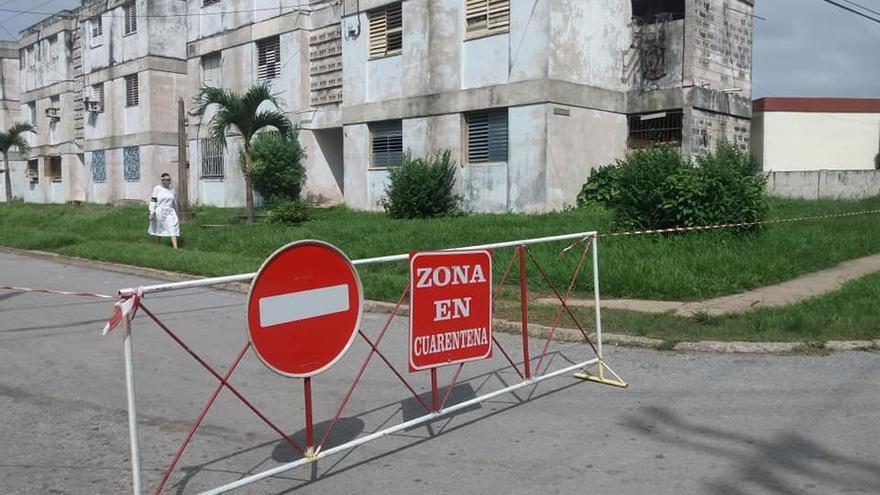
![]() 14ymedio, Havana, Pinar del Río, 5 November 2020 — “We didn’t even go out onto the balcony,” says Gerardo Ochoa, one of the hundreds of residents of the Hermanos Cruz neighborhood in Pinar del Río, confined in one of the many quarantine zones that proliferate in the province, the current epicenter of the Covid-19 pandemic in Cuba.
14ymedio, Havana, Pinar del Río, 5 November 2020 — “We didn’t even go out onto the balcony,” says Gerardo Ochoa, one of the hundreds of residents of the Hermanos Cruz neighborhood in Pinar del Río, confined in one of the many quarantine zones that proliferate in the province, the current epicenter of the Covid-19 pandemic in Cuba.
“Around here everything is full of yellow tapes or fences to prevent people from moving between one neighborhood and another,” Ochoa comments by telephone to this newspaper. “The problem is that this has caught us already exhausted, because we have so many problems caused by the coronavirus for months. When it is not the lack of products in the stores, it is the lines to buy anything, and now the isolation.”
On Tuesday night, the Ochoa neighborhood was closed down. Most of the residents live in rough three-story buildings built in the late 1980s and with serious infrastructure problems. “You have to stay at home, but many of these houses do not have the conditions for one to spend the whole day here. We have many problems with the roofs, with the water supply, not to mention the food.”
As of this Wednesday, more than 22,000 people from Pinar del Río remained under epidemiological surveillance and the massive confinement has coincided with a deterioration in the weather conditions in the west of the island. “When it rains here all the roofs lead,” added another resident of the Hermanos Cruz neighborhood who prefers anonymity and whose nephew was infected with the virus in the resurgence that started on October 6.
The outbreak affected 558 people as of Thursday. “He started to feel badly and when they tested him he was positive. Now they have him isolated and the whole family is also in quarantine.”
The complexity of the isolation in this province, with large rural areas, has made it more difficult for the authorities to detect the possibly infected. “Many people hide when they feel bad because they do not want to be taken out of their homes and taken to isolation centers,” explains a resident in the Consolación del Sur area, another of the areas most affected by infections.
In the Vueltabajo area, famous for its tobacco crops, life and the fields have also been put on hold with 21 outbreaks scattered throughout the territory. “Here we believed that the coronavirus was a thing that happened in the cities, where many people live together, and we were not prepared,” acknowledges Lázaro Rodríguez, a resident near San Juan y Martínez.
“My parents, who live in Consolación, were taken to isolation at the Faculty of Physical Culture and I have a brother who is in quarantine at the University of Medical Sciences. They are all asymptomatic but awaiting the results of the tests,” explains Rodríguez.
“It is hard because they are people used to living on their farms, being outside, and now they have had to leave behind their cultivated fields and even their animals, and live in buildings where they share small spaces with a lot of people who are in the same situation.”
“Right now we were in the middle of picking and stripping the tobacco and all that had to stop,” adds Rodríguez. “Much of this work is done inside tobacco houses and normally we have contract workers who help us, but now they cannot leave their neighborhoods or their homes because they are in quarantine.” A sawmill in Guane and several cooperatives have also been affected by the isolation.
The authorities’ solution for not completely stopping the flow of production in the most affected areas has been to keep state workers from poultry farms and other companies sheltered in the premises where they work. But private farmers cannot do the same because it is forbidden to leave or enter homes that are in quarantine areas.
“My brother-in-law has been sleeping on a chicken farm for a week and he’s desperate, because the conditions there are very bad, they don’t even have a place to rest, and they sleep on the dining room tables. In that situation, they can’t bear it,” explains Rodriguez.
For this year, in Pinar del Río, 19,890 hectares of tobacco were initially prepared for a harvest of 21,944 tons of the leaf, but meeting that number means successfully overcoming the current obstacle, which has nothing to do with rains or hurricanes that, in past years, were an obstacle.
“One spends the year taking care of the tobacco against pests, drought or downpours, but we are not prepared to also take care of the coronavirus,” Roberto Díaz, a farmer from the area near the famous Hoyo de Monterrey, tells this newspaper. The Hoyo de Monterrey area harvests the best leaf in the whole country and, some say, also in the world.
“The weather may be good, we can have the houses ready for drying and even have the resources to transport the leaf, but we lack the people because they are isolated at home and cannot go out,” says the tabacco grower. “This is the first time something like this has happened to us. We are used to and prepared for other difficulties, but not for this one.”
____________
COLLABORATE WITH OUR WORK: The 14ymedio team is committed to practicing serious journalism that reflects Cuba’s reality in all its depth. Thank you for joining us on this long journey. We invite you to continue supporting us by becoming a member of 14ymedio now. Together we can continue transforming journalism in Cuba.
